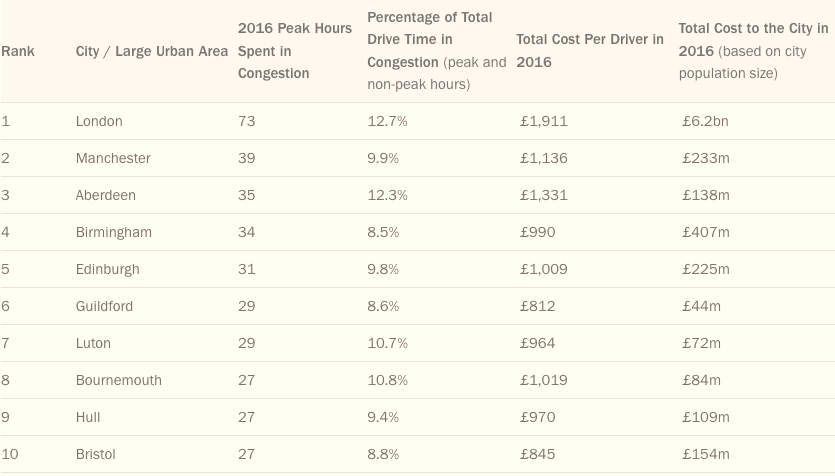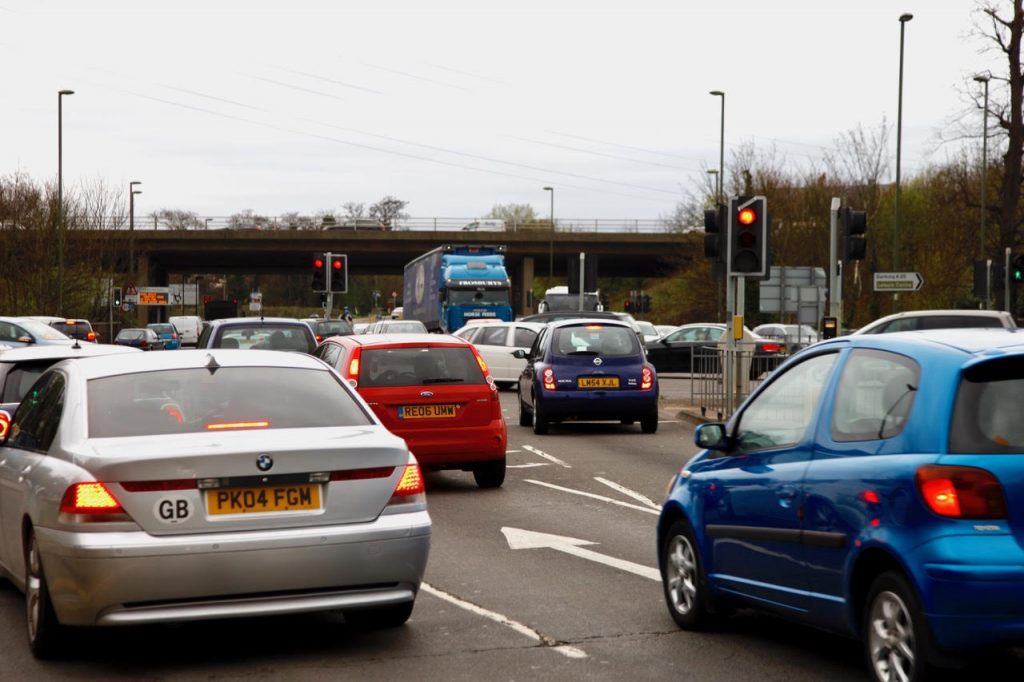 Abraham Lincoln
If given the truth, the people can be depended upon to meet any national crisis...
Abraham Lincoln
If given the truth, the people can be depended upon to meet any national crisis...
 Guildford news...
for Guildford people, brought to you by Guildford reporters - Guildford's own news service
Guildford news...
for Guildford people, brought to you by Guildford reporters - Guildford's own news service
The Dragon Says: Congestion Charging Should Not Be Ignored
Published on: 2 Apr, 2017
Updated on: 2 Apr, 2017
 We all hate congestion. Sitting in a queue of traffic when we are trying to get somewhere is extremely frustrating and if a price is put on the time wasted it comes to tens of millions of pounds, in Guildford alone.
We all hate congestion. Sitting in a queue of traffic when we are trying to get somewhere is extremely frustrating and if a price is put on the time wasted it comes to tens of millions of pounds, in Guildford alone.
So what is to be done?
Every suggestion put forward is met with criticism, even derision, from some quarter or another. Meanwhile those proposing much more development and thousands of extra car journeys in the borough seem to be just hoping for a miracle called “modal shift”, a reliance on many of us breaking our lifetime habits and walking, cycling and jumping on buses rather than jumping in our cars.
Of course that is what we need to do if we are to effect that hardest of all changes, a “cultural change”, even to tackle our existing traffic problems. But there is no real sign of the local authorities doing, with urgency, what is necessary, for instance: much improved, and safer, pedestrian and cycle routes and better, cheaper, more frequent and subsidised public transport services.
These things would all cost money and that is a diminishing resource in our councils these days. Additionally, not many of our councillors can be found among those who rely on or choose, their feet, bikes or buses to get about.
Then there is an even more serious, hidden and sinister cost to all the increasing congestion. Pollution. It is a real, albeit slow, killer, according to health experts and horribly, has a disproportionately malign effect on our young children.
A few days ago Alderman Bernard Parke reiterated his suggestion for a congestion charge. Predictably the usual counter arguments were raised.
But surely it is worth considering. There is a real environmental cost to vehicle traffic in our town centre and it must be fair for those causing it to pay something to offset it. Even if traffic levels did not decrease, the revenue could help subsidise and encourage alternative modes of transport.
We know it would not be a panacea, but congestion charging in London did, partly at least, reduce the number of car journeys there. It did even produce that holy grail, a “modal shift”.

INRIX 2016 Traffic Scorecard – UK’s 10 Most Congested Cities / Large Urban Areas – Guildford top of the list under some of the UK’s biggest cities.
In a 2008 report entitled, Congestion Charging: A tool to tackle congestion in UK cities? from the Centre for Cities, an independent, non-partisan think tank dedicated to understanding and improving UK city economies by providing city data, and policy analysis, it was concluded: “London is the one of only few world cities so far which has experienced such a modal shift and this may in part be due to the congestion charge.
“In London, the composition of traffic entering the central charging zone has changed significantly between 2002 and 2007. The amount of pedal cycles has increased by 66%, the amount of buses and coaches increased by 31% and the amount of cars and minicabs reduced by 36%.
“The corresponding increase in demand for sustainable travel modes is likely to lead to an increase in the provision of public transport, pedestrian and cycling infrastructure.
A BBC report from 2013 quoted Elliot Jacobs, a managing director of office supplies firm UOE, saying: “Getting deliveries on time is really important and the congestion charge means we have a consistency of traffic flow and a reliability that we know where the traffic’s going to be, and that’s important. It means we can get there on time…”
At the beginning of 2008 researchers from King’s College, London and the London School of Hygiene and Tropical Medicine suggested there could be unexpected health benefits from the reduction of exposure to nitrogen dioxide.
According to the researchers: “The results showed that there was little change in pollutant levels in London as a whole. But there were more substantial falls in the charging zone. Levels of NO2 fell the most.”
Then last year the chief economist at transport analysts INRIX said: “The cost of this congestion is staggering, stripping the economy of billions, impacting businesses and costing consumers dearly. To tackle this problem, we must consider bold options such as remote working, wider use of road user charging and investment in big data to create more effective and intelligent transportation systems.”
We have a choice. We can all carry on thinking it is our right to drive when and where we like, we can all blame everyone else when we are sitting in a queue of traffic, we can all turn a blind eye to the shortening of our lives caused by pollution.
Or we can start facing up to the issue.
There is a county council election coming up. Unlike Brexit, which county councillors can do nothing about, local roads are a county council responsibility. Why not ask the candidates standing in your area how they intend to tackle the problem, how they plan to cope with the thousands of extra cars that developments in this borough and beyond will bring onto our roads?
Congestion charging alone would not be a complete answer – but it could be a start.
Responses to The Dragon Says: Congestion Charging Should Not Be Ignored
Leave a Comment Cancel replyPlease see our comments policy. All comments are moderated and may take time to appear. Full names, or at least initial and surname, must be given.
Recent Articles
- Burglar Jailed Thanks To Quick Action of Ash Resident
- Highways Bulletin for December
- Birdwatcher’s Diary No.318 Some Pre-Christmas Rambles
- Merry Christmas and a Happy New Year to All Our Contributors and Readers!
- More Units Added to Solums’s Station Redevelopment
- Vehicle Stop on Epsom Road Leads to Prolific Drug Gang Being Put Behind Bars
- Local Political Leaders Respond to Publication of the English Devolution White Paper
- Flashback: Guildford All Lit Up For Christmas – Then And Now
- City Earn Themselves a Three Point Christmas Present
- Mayor’s Diary: December 23 – January 4


Recent Comments
- Aubrey Leahy on Vehicle Stop on Epsom Road Leads to Prolific Drug Gang Being Put Behind Bars
- Sheila Newton on Memories of the Dennis Bros Christmas Party
- John Perkins on Two Unitary Authorities, One Elected Mayor – Most Likely Devolution Outcome for Surrey
- Gavin Morgan on Merry Christmas and a Happy New Year to All Our Contributors and Readers!
- David Roberts on Local Political Leaders Respond to Publication of the English Devolution White Paper
- Steve Grove on Merry Christmas and a Happy New Year to All Our Contributors and Readers!
Search in Site
Media Gallery
Dragon Interview: Local Artist Leaves Her Mark At One of England’s Most Historic Buildings
January 21, 2023 / No Comment / Read MoreDragon Interview: Lib Dem Planning Chair: ‘Current Policy Doesn’t Work for Local People’
January 19, 2023 / No Comment / Read MoreA3 Tunnel in Guildford ‘Necessary’ for New Homes, Says Guildford’s MP
January 10, 2023 / No Comment / Read More‘Madness’ for London Road Scheme to Go Ahead Against ‘Huge Opposition’, Says SCC Leader
January 6, 2023 / No Comment / Read MoreCouncillor’s Son Starts Campaign for More Consultation on North Street Plan
December 30, 2022 / No Comment / Read MoreCounty Council Climbs Down Over London Road Works – Further ‘Engagement’ Period Announced
December 14, 2022 / No Comment / Read MoreDragon Interview: GBC Reaction to the Government’s Expected Decision to Relax Housing Targets
December 7, 2022 / No Comment / Read MoreHow Can Our Town Centre Businesses Recover? Watch the Shop Front Debate
May 18, 2020 / No Comment / Read More












Bibhas Neogi
April 2, 2017 at 8:18 pm
Guildford is not anything like London. It is sheer madness to compare the two. It is a gap town and there are no viable alternative routes.
Congestion in Guildford is the result of doing nothing to improve the road network for the last 40 years.
Surrey County Council has done nothing to deal with the gyratory traffic problems except holding exhibitions and talking about options. They had funding from the M3 LEP of £3m but sat on it for the last three years cogitating about the Local Plan etc.
They have wasted money on consultants fees and evaluated worthless options and left out the very one that will really solve the problems. Guildford is still relying on the only bridge for east west traffic that was built in 1845!
They have finally jumped on the band wagon of modal shift – an easy excuse for not doing anything except talk more about things like sustainable corridor whilst not improving bus facilities.
All in all an unparalleled inaction by the county responsible for Guildford’s traffic woes.
Bernard Parke
April 3, 2017 at 9:08 am
Guildford is of course nothing like London but it has been rated the sixth most congested town in the UK.
It has also been recently reported that new road systems increase traffic and in doing so pollution becomes the by-product.
Why should not through traffic pay a congestion charge and in doing so help pay for the maintenance of the road that they are using?
The new developments planned in the pipe line will not of course help solve this infrastructure problem which also includes ancillary services such as schools etc.
Bibhas Neogi
April 3, 2017 at 8:13 pm
When improvements to congested network is made it attracts a lıttle more traffic because a few start to use theır cars ınstead of other modes because of convenience. It ıs not true to say that all extra capacity ıs used up by more traffic.
Improvements to public transport, change of travel needs due to use of internet should reduce demand on road space. Pollution ıs goıng to reduce as more electric cars replace polluting ones.
A balanced approach ıs needed. A congestıon charge would not reduce congestıon appreciably because there are no viable alternative routes bypassıng Guildford town centre. It would be sımply be another form of tax. If tax has to be ıntroduced to subsıdıse public transport or repair potholes etc., that should be the job of central government not local authorıtıes.
Surrey County Council and Guildford Borough Council should have a hard look at what they have done to ımprove transport. Precious lıttle I would say.
A new east west route over the tracks and the rıver, puttıng the Mıllbrook and Onslow Street stretch ın a tunnel are the answers to Guildford’s traffic problems. At the same tıme the town centre would become pedestrian frıendly.
Sally Parrott
April 3, 2017 at 7:23 pm
Something must be done. Pollution near Bramley Infants School, Sandford Primary and Guildford Children’s Centre must be damaging, and the waste of time and fuel is shocking.
But congestion charging? The rich carry on polluting, but ordinary small businesses needing equipment, like window-cleaners, plumbers and gardeners, face hardship.
A few possible ideas which will not interest councils because they don’t involve revenue might include:
* express buses to Shalford Station with shuttle trains to Guildford;
* a total ban on deliveries to central Guildford except in the very early mornings, thus cutting down on HGVs during the day;
* subsidised bus fares;
* some system to link drivers and passengers to encourage car-sharing, especially returning from Guildford Station in the evening;
* avoiding more house-building in Cranleigh and Dunsfold until the problem of the A281 at Bramley is solved.
David Wragg
April 4, 2017 at 1:54 pm
You really can’t impose a congestion charge unless and until an alternative is available for through traffic, and let’s face it, there are many residential properties close to the town centre whose occupants and visitors would be hard hit.
As Bibhas Neogi writes, Guildford is a gap town and there are no viable alternative routes. Building a circular road around Guildford would require tunnelling, which would be costly and difficult given the low lying areas around the River Wey.
Modal shifts might be possible with commuters and some shoppers, but would not be possible for through traffic, and in any case, shoppers use the car as a large shopping trolley these days and won’t carry lots of heavy bags for which there would be no space on buses or trains.
Bernard Parke
April 4, 2017 at 3:25 pm
Our roads are riddled with pot holes and a congestion charge would help with repairs, as I have mentioned before.
Excise duty replaced road tax and it only fair that those using our road system should contribute to their upkeep.
Those living in the town centre could be made exempt. There already exists a very costly park and ride system, one of which is greatly underused.
Nevertheless we could keep this exchange going for some considerable time, but frankly what is the use?
All comments fall on deaf ears. But do not despair we have an election next month.
Bibhas Neogi
April 4, 2017 at 10:02 pm
Only about 15% of revenue collected from the motorists and the hauliers is spent on roads. So it would not be just to squeeze motorists for even more taxes like congestion charging. In Guildford, the reduction in congestion would be insignificant since there are no viable alternative routes.
The reason for greatly unused Onslow Park and Ride is because access to it is tortuous and congested. Access should have been off the A3 but at the time of the construction of this scheme, the A3 widening was pulled out of the road programme, so the counties had no choice but to go ahead with access off Gill Avenue.
Now that the A3 widening is back on the programme, let us hope the Highways England would provide access from and exit to the A3 from this site.
As I said before, the solution to Guildford’s congestion is there if the counties are bold enough to take a holistic approach with the short, medium and long term solutions outlined on my website.